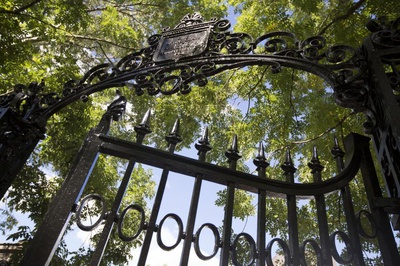
News
Nearly 200 Harvard Affiliates Rally on Widener Steps To Protest Arrest of Columbia Student

News
CPS Will Increase Staffing At Schools Receiving Kennedy-Longfellow Students

News
‘Feels Like Christmas’: Freshmen Revel in Annual Housing Day Festivities

News
Susan Wolf Delivers 2025 Mala Soloman Kamm Lecture in Ethics

News
Harvard Law School Students Pass Referendum Urging University To Divest From Israel
Harvard Professor-Led Company Says It Reconstructed Genome of Extinct Tasmanian Tiger

Colossal Laboratories and Biosciences, a company co-founded by Harvard professor George M. Church, announced last week that it had reconstructed the genome of the extinct Tasmanian tiger with more than 99.9 percent accuracy — the most complete ancient genome of its kind.
The discovery marks a major milestone in a two-year project to resurrect the extinct animal — a marsupial, known as the thylacine, which went extinct in 1936. The project was able to successfully identify “Thylacine Wolf Accelerated Regions,” parts of the genome responsible for the unusual wolf-like structure of the animal’s skull that gave it its name.
But the finding has come under some scrutiny from scientists, who questioned the company’s decision to announce the discovery in a press release without providing a formal, peer-reviewed paper or releasing data.
“I think with good reason, science should not be done by press release,” said Andrew J. Berry, a lecturer in the Organismic and Evolutionary Biology department.
“I just think it’s a little irresponsible, frankly, to make strong claims — scientific claims — without backing it up with the data,” Berry added.
Though Church did not respond to a request for comment, Colossal CEO Ben Lamm defended the decision to issue a press release before publishing a research paper in an interview with NewScientist.
“We are not an academic lab where papers are their main focus,” he said.
According to the press release, the project’s goal is “returning the Thylacine to native Tasmania.”
Berry called the discovery “a spectacular technological achievement,” but said he had concerns about whether it would be feasible to fully release the thylacine back into the wild.
“The habitat no longer exists,” Berry said. “So, no, it’s not a viable project.”
He added that the researchers were still “a million miles away from an actual organism.”
But Colossal predicts the 45 remaining gaps in the genome will be filled in the coming months, producing the full DNA of the animal.
Colossal also engineered a technology that would give the thylacine resistance to Cane Toad Toxin that would otherwise be fatal — a vital factor for de-extinction efforts.
“I see a future in which genome editing of wildlife species is another essential tool for biodiversity conservation,” said Beth A. Shapiro, Colossal’s chief science officer.
Want to keep up with breaking news? Subscribe to our email newsletter.
Most Read
- Harvard Dismisses Leaders of Center for Middle Eastern Studies
- Harvard Agrees to a 1-Year $6 Million PILOT Agreement With the City of Cambridge
- FAS Dean Asks Center Directors To Show Compliance With Viewpoint Diversity Guidance
- 2 Years After Affirmative Action Ruling, Harvard Admits Class of 2029 Without Releasing Data
- Adams House Resident Dean Issues Warning to Student Who Booked Room for AFRO Event
From Our Advertisers

Over 300+ courses at prestigious colleges and universities in the US and UK are at your disposal.

With innovative financial tools combined with financial education, Collegiate empowers students to take control of their finances and build confidence in their money management skills.

Serve as a proctor for Harvard Summer School (HSS) students, either in the Secondary School Program (SSP), General Program (GP), or Pre-College Program.

With an increasingly competitive Law School admissions process, it's important to understand what makes an applicant stand out.

Welcome to your one-stop gifting destination for men and women—it's like your neighborhood holiday shop, but way cooler.

Admit Expert is a premium MBA admissions consulting company, helping candidates secure admission to top B-schools across the globe with significant scholarships.
